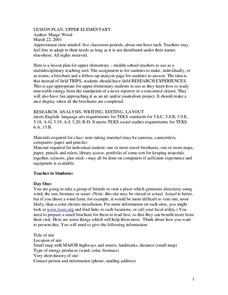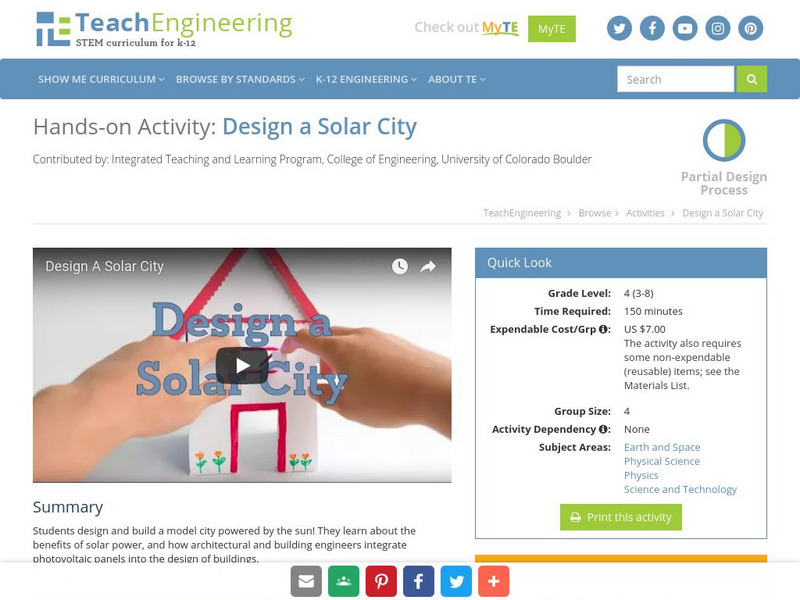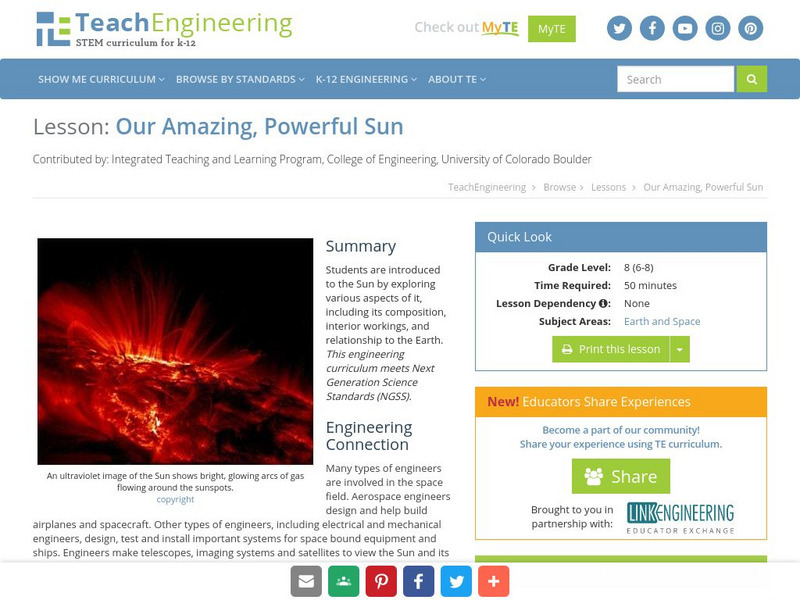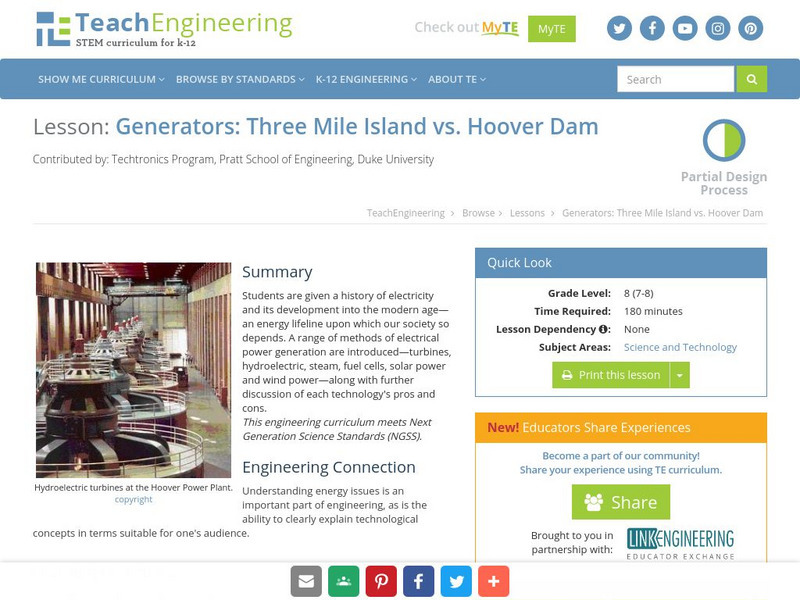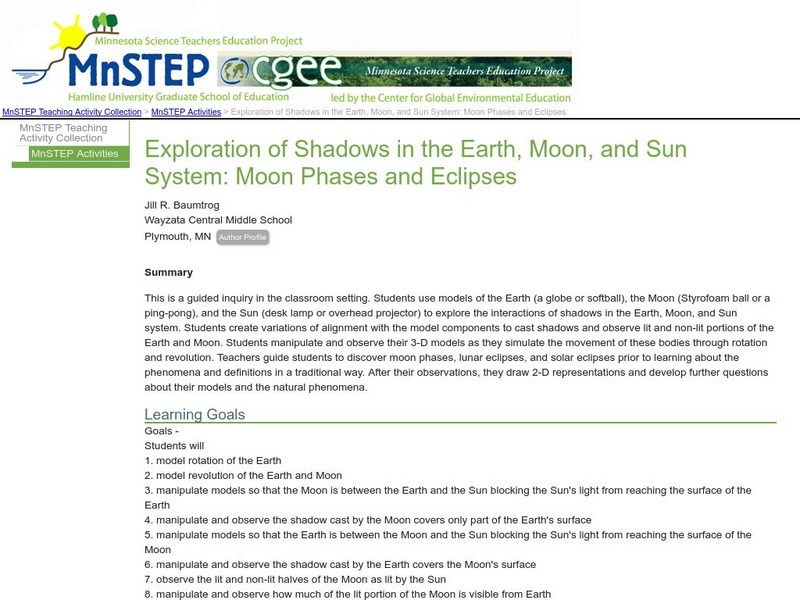Curated OER
Solar Energy
Students investigate solar energy. They explore ways that energy from the sun can be turned into energy that humans can use in our everyday lives. In various experiments, they explore the effect of clouds and dust on photovoltaic energy...
Curated OER
The Solar System
Students study the planets of the solar system. Students observe a model of the solar system, and name each planet, in order. In pairs, students write acronyms to assist in remembering the plants in order and share them with their...
Curated OER
Heat from Light
Second graders explore solar energy. In this science lesson, 2nd graders use hand lenses to see that light energy can be converted to heat energy.
Curated OER
Solar
Learners study solar energy. For this renewable energy lesson students complete several lab activities using different controls and variables.
Curated OER
"I, Robot"
Seventh graders define vocabulary and discuss the characters in a movie. In this solar station lesson plan students explore robots on the Internet.
Curated OER
Renewable Energy
Students identify how to study renewable energy from the standpoint of a news reporter or a concerned citizen. Then they approach art in a fun way through a journalism project that includes create a brochure for display. Students also...
Science Buddies
Science Buddies: Solar Cell Power Output vs. Temperature
Solar cells provide a clean way of making electricity directly from sunlight. In this project you will build a simple circuit and experimental setup to investigate whether the power output of a solar cell changes with ambient temperature.
Climate Literacy
Clean: Solar Water Heater
Student teams design and build solar water heaters to capture energy in the form of solar radiation and convert it to thermal energy. Once the model devices are constructed, young scholars perform efficiency calculations and compare...
TeachEngineering
Teach Engineering: Renewable Energy Living Lab: Energy Experts
Students use real-world data to evaluate various renewable energy sources and the feasibility of implementing these sources. Working in small groups, students use data from the Renewable Energy Living Lab to describe and understand the...
TeachEngineering
Teach Engineering: Solar Power
In this activity, students learn how engineers use solar energy to heat buildings by investigating the thermal storage properties of some common materials: sand, salt, water and shredded paper. Students then evaluate the usefulness of...
TeachEngineering
Teach Engineering: Zero Energy Housing
Students investigate passive solar building design with a focus solely on heating. They learn how insulation, window placement, thermal mass, surface colors, and site orientation play important roles in passive solar heating. They use...
TeachEngineering
Teach Engineering: Design a Solar City
Students design and build a model city powered by the sun! They learn about the benefits of solar power, and how architectural and building engineers integrate photovoltaic panels into the design of buildings.
TeachEngineering
Teach Engineering: Passive Solar Design
Young scholars are introduced to passive solar design for buildings--an approach that uses the sun's energy and the surrounding climate to provide natural heating and cooling. They learn about some of the disadvantage of conventional...
TeachEngineering
Teach Engineering: Maximum Power Point
Students learn how to find the maximum power point (MPP) of a photovoltaic (PV) panel in order to optimize its efficiency at creating solar power. They also learn about real-world applications and technologies that use this technique, as...
TeachEngineering
Teach Engineering: Our Amazing, Powerful Sun
Middle schoolers are introduced to the Sun by exploring various aspects of it, including its composition, interior workings, and relationship to the Earth.
TeachEngineering
Teach Engineering: Generators: Three Mile Island vs. Hoover Dam
Students are given a history of electricity and its development into the modern age lifeline upon which we so depend. The methods of power generation are introduced, and further discussion of each technology's pros and cons follows.
TeachEngineering
Teach Engineering: From Sunlight to Electric Current
The lesson will first explore the concept of current in electrical circuits. Current will be defined as the flow of electrons. Photovoltaic (PV) cell properties will then be introduced. This will lead to the principle of "Conservation of...
PBS
Pbs Nova: Design a Renewable Future
This interactive Lab investigates what energy is, how it can be converted into useful forms, and why some sources are running low. The Research Challenge allows students to design their own renewable energy systems to generate power in...
US Energy Information Administration
U.s. Eia Energy Kids: Energy Sources: Renewable
Learn about renewable energy sources including biomass, which includes biofuels, hydropower, geothermal, wind, and solar.
Other
Nasa: Helioviewer Project
Explore the sun with this solar data browser! The website allows students to see images of the sun for any amount of time or length. Students can take screen shots or make movies based on their observations. Also included is a slideshow...
Energy4Me
Energy4me: Great Energy Debate
After learning about all the energy sources, students will be able to list and identify the economic and environmental advantages and disadvantages of them.
Science Education Resource Center at Carleton College
Serc: Exploration of Shadows: Earth, Moon, Sun System: Moon Phases Eclipses
A guided inquiry where students participate in the simulation of moon phases and eclipses.
TED Talks
Ted: Ted Ed: How to Fly Around the World Without Fuel
Imagine if we could fly day and night using only solar energy. The expertly engineered Solar Impulse plane is flying around the world delivering a powerful message: clean technologies can achieve the seemingly impossible. Powered by a...
TED Talks
Ted: Ted Ed: Why Aren't We Only Using Solar Power?
Solar power is cheaper and more sustainable than our current coal-fueled power plants, so why haven't we made the switch? The real culprits here are the clouds, which make solar power difficult to control. Alexandros George Charalambides...







